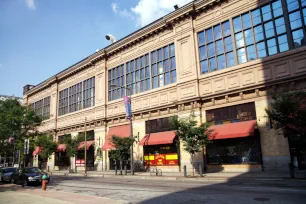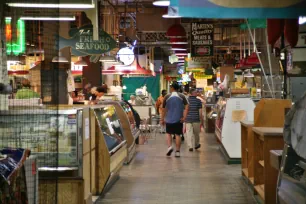A Philadelphia landmark since 1892, the Reading Terminal Market treats visitors to a bevy of different foods in an historic setting.
How the Market Grew
In the early days of colonial America, outdoor “farm” markets were quite popular. They provided fresh foods for people who lived in cities such as Philadelphia and were conveniently located in the center of town.

However, by the mid-nineteenth century, outdoor markets were falling out of favor, mostly because they were often a health hazard and also interfered with streetcar traffic. So, Philadelphia decided to take their outdoor markets inside and, with the help of the Reading Railroad, opened the Reading Terminal Market in 1892.
The Building
The building that houses the market was designed by F. H. Kimbal of the Wilson Brothers Architecture & Engineering firm and was one of the largest single-span arched roof structures in the world at the time it was built. It is now believed to be the oldest such structure, and the only one of its kind left in the United States. The design is of the Italian Renaissance style, and the interior boasted ornamental plaster and marble.
An instant hit


The market was an instant hit and was lauded for its state-of-the-art refrigeration system and the variety of foods offered at the site. Indeed, Reading Terminal Market, situated below the railroad terminal itself, boasted room for 800 vendors. Each would set up shop in small six-foot stalls.
Because of the market’s ties to the railroad, suburban housewives could purchase their groceries from the vendors and have it delivered to them on the train without ever having to venture into the city. Later, trucks were used for the same service.
Changes
Despite the lean years of the Depression, the Reading Terminal Market continued to thrive through the 1930s and into the years of World War II. Unfortunately, however, as railroads lost popularity and people turned to automobile and plane travel in the 60s and 70s, the market suffered. By the time the Reading Railroad folded in 1976, little was left of the once vibrant market. And by 1985, the terminal above was no longer in use, with local trains having been re-routed to a new terminal.
However, many Philadelphians remained concerned about the demise of the market and rallied the Reading Company (now a real estate business that still owned the market) to revitalize the market. The company listened and by the 1980s, the market was on its way up.
Today, Reading Terminal Market is once again a vibrant entity and is the perfect location for locals and visitors to enjoy lunch or shop for fresh seafood, meat, veggies, fruit, and desserts to take home for dinner. You’ll also find vendors peddling books, clothing, crafts, and other goodies as well on the markets “12 streets and 4 avenues”.
The market also hosts live concerts, and some of the vendors even hold cooking classes on site.

